How to start potty training
Getting equipped * Prepping the child * A suggested structure for training * and some other tips
You may already know WHEN to start, but wondering HOW to start potty training.
[ If you still have questions on WHEN, visit our
When to Start page
, where you can find information about timing and toilet training readiness, including tips on building readiness -- mainly from a parenting point of view. ]
The When-To-Start page is about planning potty training, both from a logistical perspective, and emotional:
Being in the right state-of-mind, brushing-up on personal & parental skills, having some sort of vision for the training, etc.
This page is about DOING: How to start potty training in practice.

[ --- Quick note --- we don’t intend here to outline a specific method like “potty training in one weekend/day/by-noon”.
It’s more about suggesting principles that can work as foundation (if you decide to adopt them), for whichever specific model of potty training you may choose to follow. ]
In this page you will find:
-
Things to do just before you start: Preparing the home environment, talking to the child, getting the relevant equipment.
-
Suggested structure and guidelines for leading toilet training; coming from an approach that the parent is leading the training.
-
Suggested tips for responding to potty training accidents.
And more.
How to start potty training: let my child know (setting expectations)
Regardless of how much I believe my child is mature and ready for toilet training, I’d still want to prepare him for what we’re going to do; wouldn’t want to just spring it out on him without initiating some sort of Prep-talk (that would fit his age.)
I guess we all meet conflicts and power-struggles in everyday parenting, potty training included. But some of those “bumps” can be minimized by setting clear expectations (or boundaries).
[ Pretty sure most parents have seen that kids respond well to knowing what’s going on and what is expected of them. (To be honest, so do adults.) ]
Setting expectations and setting boundaries before starting potty training can “set the tone right” for the whole process.
This article suggests some ideas/guidelines for prep-talking children before starting potty training.
How to start potty training: Home preparations
Let’s set our expectations straight:
When first starting potty training, there will be potty training accidents. For some kids those accidents will be few, and may even stop completely after 3-5 days.
For others, it may continue for a while.
Applying a few simple changes around the house before starting potty training
, may help keep your reactions to potty-training-accidents calm, sensible, and to-the-point (more about that, later).
Getting equipped for potty training: Toilet vs. Potty
There are many toilet training products. From Potty Chairs (potties) or Toilet Training Seats to potty training pants, potty training books, DVDs, and potty training peeing dolls.
Some items are basics and “must”. Some are optional, and - could be fun.
I’ve prepared a short Report on potty training equipment, attempting to cover both types.
…But first: here’s a basic question, one of personal preference:
Training on Toilet -- or Training on Potty?
Potty Chair is an “intermediate prop”. We don’t expect children to use it after a certain age. Is Potty a necessary phase for children, between diapers and “grownups toilet”?
Some parents choose to skip the “potty phase” completely, and have their child learn to use the toilet from Day 1. (I did)
There are some great options featured today as Toilet Training Seats, making it simple for children to safely and pleasantly sit on the toilet, and saving parents the bother of emptying and washing a Potty.
It’s strictly subjective of course; personally, I think there are some strong advantages to Toilet over Potty, aside from not having to empty & wash it.
If you’re interested, read this
short discussion about Training on Toilet vs. Training on Potty -- advantages and disadvantages of both options.
Getting equipped for potty training: Essential and Optional
Click here to get a general review of potty training equipment, from essential to optional.
[Note: This is not a specific Products Description - rather a general review of relevant stuff.]
How to start potty training: Suggested structure and guidelines
In this section you'll find a suggested model/structure for the training process itself.
Note: The tips/guidelines brought in this section align with a structured, parent-led approach for toilet training. Read it if you’re comfortable with such approach.
Suggested “structure” for how to start potty training:
-
Plan to spend ~3 days at home with your child (overlapping with weekend is probably better for working moms). Those few days should be completely dedicated for toilet training.
-
Tell your child what’s going on (“we are starting potty training”). Explain in simple words what it means and repeat it during the first few mornings of potty training.
-
Parent-led structured approach is different from a child-oriented potty training approach: During the course of the first 2-3 days, don’t expect the child to announce when he needs to go potty. At this point it’s still the parent’s responsibility to initiate the potty trips.
There are two ways to do this:
(1) Recognize when the child needs to go by watching the body language
(2) Initiate scheduled potty trips every X minutes: start with every 10 minutes, then 20 min, 30 min, until you get to 1 hour.
You could also combine the two methods. Anyhow, you start with frequent potty trips and gradually space them apart.
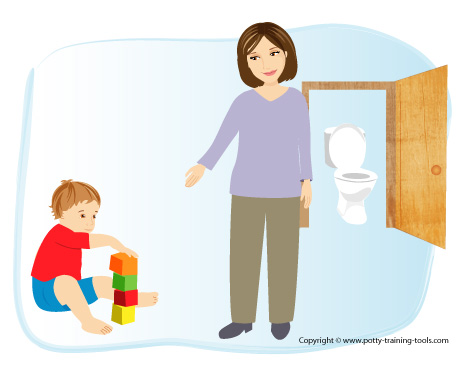
-
Whenever your child is posing gestures of needing to go potty, it may be a good idea to try and “verbalize it for him”, coaching him to become aware of that feeling.
-
Get your child to drink plenty of fluids in the first stages of potty training. (If needed -- reduce to juice…)
-
Once you start potty training, and assuming you feel OK with the parent-led approach, don’t be tempted to go back on the diaper. It would only confuse the child and send a message that you’re not sure about this.
So, also -- don’t start if you’re not feeling completely up to it.
How to start potty training: The challenges of getting the child to poop in the toilet
Getting children to poop in the potty or toilet is much trickier than getting them to pee in it. It’s practically impossible for parents to control it. And the fact is many children experience some sort of “emotional blockage” around this passage.
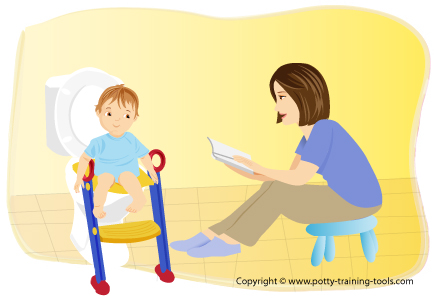
Some kids get over it quickly, and for others it can remain a challenge for a while.
So as parents, we can’t manage our kids’ poop for them… What CAN we do to make the poop-aspect of potty training easier?
-
We can try to give foods that encourage bowel movements, like fruits & vegetables, whole-wheat or bran cereals. And the drinking part is extremely important here too.
-
If you already know that your child tends to constipate, you may want to use some sort of preventive medication when you’re starting potty training.
[Personally I’m familiar with PEGLAX (local brand name for Polyethylene Glycol 3350) -- a non addictive food supplement, comes in the form of granules that you can add to any drink. It adds volume to the Poop and makes the bowel movement soft.]
Visit this page for more information about PEG 3350 and helping children with bowel movements.
…What else?
-
Encourage your child to have a “potty sit” after meals, especially if he normally goes pooping in regular hours (when in diaper). Don’t force it or stress it, and don’t make them too long. (If they don’t go, we have to let it go.)
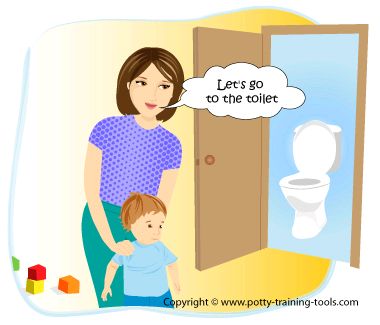
How to start potty training: Responding to potty training accidents
The essence what’s written below was given to me by a professional consultant for child’s education and development, when we were having troubles potty training our first boy.
I have “flexed” it a little since then, based on my experience and after hearing from other moms about theirs.
-
Probably the most basic guideline is -- we need to watch our tone and what we are projecting to the child: Don’t get angry, don’t get upset or frustrated. Keep very calm and assertive and keep our words “to the point”.
It is sometimes hard, but that’s where we need to manage ourselves.
-
When the child poops or pees in his cloths, we want him to know that this is not the desirable behavior. So we could say something like “Your cloths are wet/dirty and it doesn’t feel good. Let’s go change now.”
Parents often tend to say things like “Oh, that’s OK sweetie! Nothing happened!”
And the problem with this response is that it sends only half the message.
So we need to think not only about making them feel OK, but also about what we’re trying to teach them.
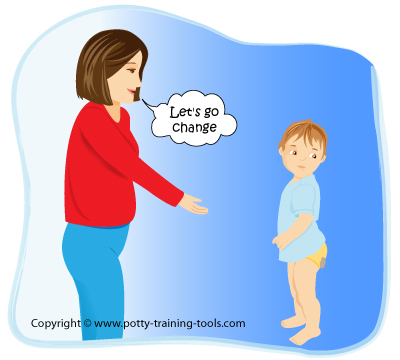
-
It is also important to act quickly when responding to potty training accidents: Don’t allow them to stay in their wet or dirty cloths.
-
And with this memory in mind, I should also say -- use your good sense of judgment:
There is a difference between a child who is only starting potty training and is having the expected occurrences of potty training accidents, and a child who’s been there for a while and has started to develop a behavior of peeing and pooping in his cloths.
Different situations require different way of handling.
How to start potty training: Getting into more relaxed routine
After 3-4 days of structured potty training, your child may have already mastered the basic idea of peeing in the toilet.
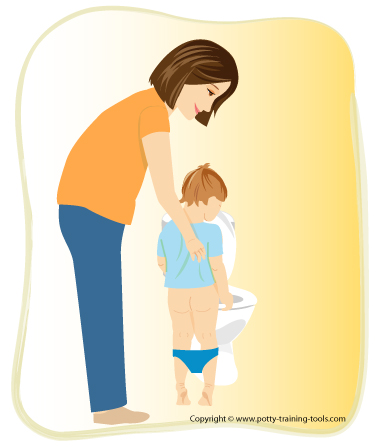
If he’s mastered the pooping part as well then, no doubt, you are raising a champion. If not, don’t stress about it. Keep doing what you can to support easy bowel movements, and try to create a routine for him to sit in regular hours.
It’s still an early stage, so the important thing at this point is to prevent constipation as much as possible, and avoid getting him stressed out or scared from pooping in the toilet.
Now is the time to STOP initiating potty breaks for pee or reminding your child to go. Let him manage himself and see how it goes.
This may also be a good time to go outside the house. Visit friends and family, or make trips to the mall.
I know some parents who use Pull-ups when going outside the house, during the early stages while they still feel they can’t trust the child not to wet/soil.
Personally I don’t recommend it because I think it sends the wrong message. But that’s just me.
How to start potty training: Night potty training
Night potty training is a different story than daytime potty training, as it’s more about the physiological aspect and has very little to do with education and training.
In that sense, it is usually recommended to separate between the two and wait with night training until daytime potty training is fully mastered.
(I’ll have a separate page written for this topic in the near future.)
Return from How to Start Potty Training to
Potty Training Tools Home page